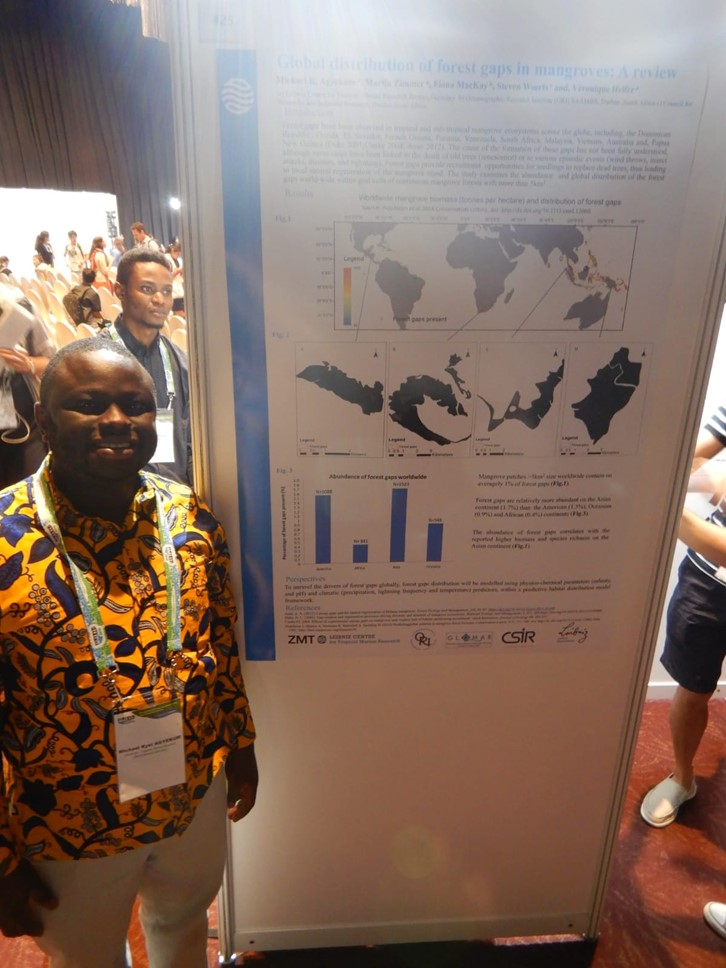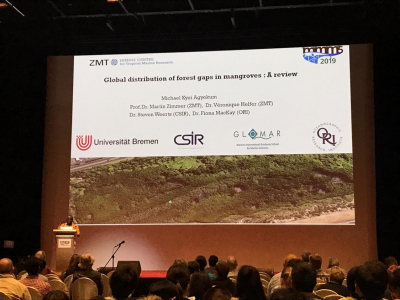- Graduate School GLOMAR
- PhD student reports
- Conference Reports
- Conference Reports 2019
- Michael Kyei Agyekum
Michael Kyei Agyekum
Report of GLOMAR PhD student Michael Kyei Agyekum about his participation in the Mangrove Macrobenthos Management Meeting (MMM5) in Singapore from 1 to 5 July 2019
The MMM is a series of the longest and largest international conference organised triennially by the mangrove scientists in locations around the world where mangroves form an integral component of the coast. The conference is used to highlight the importance of mangrove conservation and the benefits of the mangrove ecosystem services to mankind. This year the conference was convened in Singapore from 1-5 July 2019 with the highest participation of about 400 mangrove scientists around the globe in attendance.
The conference was opened with a stimulating talk from Prof. Norman Duke of the James Cook University, titled “Coastal and Estuarine Mangrove Ecosystems are feeling the pinch – What do we know about the threats, the processes affected, and the prognosis for not coping?” This exciting talk reviewed the broad environmental conditions and constraints that define the mangrove tidal wetland habitat. There were quite a several interesting talks during the mangrove loss, deforestation and degradation session that notably included “Trends and changes in mangroves canopy height, biomass and carbon stocks”. In this talk, a more recent trend in mangrove growth, cover and carbon stock changes with a focus on Africa and Asia based on a combination of time series analysis of Landsat and Sentinel, LIDAR and SAR data. This study is in line with the aspect of my project of understanding the development of the different phases of forest gaps and their potential implication for the carbon stocks. In the Blue carbon session, most presenters focused on carbon accumulation rates, stocks, sinks, and sources in the mangrove forest. Prof. Victor Rivera-Monroy revealed in his talk that phosphorus is a critical driver controlling mangrove carbon storage in the Everglades mangroves. The findings of his study indicate that almost a decade after the hurricane impact in the Everglades, there is still a total phosphorus legacy that controls forest growth and productivity by the rapid recovery of the forest canopy irrespective of the significant defoliation in the last four years. The findings of the study fit with my research question on which limiting nutrients and fauna are crucial for the regeneration of the forest gaps.
I had the opportunity to present my study in a 3 minutes lightning talk to highlight my poster titled “Global Distribution of forest gaps in mangroves: A review”. I shared with the audience the cause of formation of these gaps and the possible ecological consequences on mangroves. My study showed that forest gaps are located more abundantly on the Asian and American continents. I had fruitful discussions with senior scientists and practitioners working in forest gaps in South East Asia during the poster session. We deliberated mostly on efficient methods of identifying gaps of different ages using satellite data and how to effectively measure carbon stocks in the forest gaps and the surrounding matured forests.
Overall, the conference allowed me to communicate my research to a larger audience of mangrove scientists working on similar topics. I had very good feedback for my study and an overview of current research on forest gaps in mangroves using state of the art technology such as unmanned aerial vehicles, LIDAR and Sentinel data. Most importantly I expanded my network of contacts in the mangrove scientific community. I acknowledge the financial support of GLOMAR and the ZMT making it possible for me to attend the conference.




